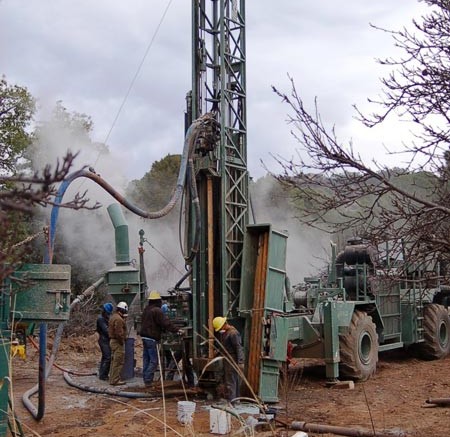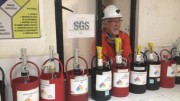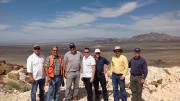VANCOUVER — According to Coeur Mining (TSX: CDM; NYSE: CDE) president and CEO Mitchell Krebs, the company’s proposed friendly takeover of junior Paramount Gold and Silver (TSX: PZG; NYSE-MKT: PZG) is one of the most “logical and strategic acquisitions” across the industry.
Paramount’s San Miguel discovery borders Coeur’s Palmarejo silver-gold operation — 15 km northwest of the town of Temoris in northern Mexico — and the potential operational synergies appear to have been too enticing for the producer to ignore, especially while Coeur closes down Palmarejo’s open-pit operations to improve margins with higher-grade, underground ore.
Under the agreement Coeur will acquire Paramount in an all-share transaction worth US$146 million, with Paramount shareholders receiving 0.2016 of a Coeur share per Paramount share held.
The purchase price equates to 90¢ per Paramount share based on Coeur’s 20-day, volume-weighted average price of US$4.47, which represents a 20-day, 19.8% premium.
But the junior made out a bit better than that, as Coeur will also inject US$10 million into a spin-out company that will host Paramount’s non-Mexican assets. Tack on the US$5 million Coeur will pay for a 0.7% net smelter return (NSR) royalty Paramount held at San Miguel, and the total purchase price for the project eclipses US$160 million.
The immediate draw for Coeur is the high-grade, silver-gold resource ounces added to its near-term production profile at Palmarejo. Paramount’s biggest find at San Miguel has been the Don Ese deposit, which extends across a shared property boundary onto Coeur’s land holdings, and is located 800 metres from the producer’s Guadalupe deposit.
Coeur plans to develop Don Ese using a 1 km decline next to the Guadalupe surface infrastructure at an initial cost of US$15 million next year. The company anticipates initial production from Don Ese by the end of 2015, ramping up to 2,500 tonnes per day by the end of 2017.
“This is a transaction that makes a ton of sense for both companies, and it has been a long time coming. It gives us a high-quality production profile that we expect will yield strong free cash flow,” Krebs said during a conference call. “It’s low risk since it’s in the same area as our current development and mining activities, and we’ll be processing basically the same material.”
“We’re looking at something that has low capital requirements. It takes advantage of our infrastructure as we transition away from Palmaerejo’s open-pit and underground. Things like equipment and labour can be transferred over to these new sources of mill feed,” he added.
Don Ese hosts 3.4 million measured and indicated tonnes grading 177 grams silver per tonne and 2.32 grams gold per tonne. Meanwhile, Guadalupe’s underground reserves total 5.4 million tonnes averaging 111 grams silver and 1.59 grams gold. Coeur anticipates recovery rates of 80% for silver and 95% for gold at Don Ese.
Assuming excess capacity is used at Palmarejo’s 6,000-tonne-per-day processing facility, Coeur says the combined Don Ese and Guadalupe deposits could produce 6 million oz. silver and 110,000 oz. gold annually over the next eight years. For comparison, 2014 production at Palmarejo is expected to be 6.7 million to 7.2 million oz. silver and 87,000 to 95,000 oz. gold.
“Permitting is another synergistic area where we can take advantage of what we already have in place at Palmarejo. We’re developing over to the property boundary, and no new permits will be needed, given that we’d be developing from underground and not anticipating any new surface disturbances,” Krebs continued. “The ejido we’ll be dealing with is that same one that’s on our ‘side of the fence,’ so to speak.Compared to a stand-alone acquisition activity, we’re much more capable of mitigating the risks.”
Though Don Ese will be Coeur’s near-term focus, Krebs pointed out that the company will also acquire the greater 1,210 sq. km San Miguel property package that surrounds the Palmarejo complex. He said the project holds “a significant amount” of silver and gold resources, in the form of seven other deposits that “provide lot of optionality on any future increases in metal prices.”
San Miguel’s global measured and indicated resources total 43 million tonnes grading 46 grams silver and 0.68 gram gold. Coeur has identified more exploration potential on other high-grade structures near the shared property boundary in addition to several lower-grade deposits.
“Don Ese actually goes over the shared property boundary onto our ground, where it goes by the name of Independencia. As our exploration efforts at Palmajero have transitioned towards higher-grade, underground targets, it has been a real focus of ours,” Krebs says. “We plan to tunnel over to the combined deposit over the next year. We’re confident that Palmerjo will be positioned to remain one of the largest silver and gold mines in Mexico, with a compelling future ahead of it.”
On Dec. 19 Coeur released a maiden resource estimate at Independencia that the company said shows the success of its efforts to identify more high-grade mineralization. The resource is 300 to 400 metres deep and remains open at depth and along strike to the northwest.
Independencia hosts 1.7 million measured and indicated tonnes grading 115 grams silver and 2.07 grams gold. Inferred resources total 477,200 tonnes of 70.3 grams silver and 1.3 grams gold. Contained metals are pegged at 7.7 million oz. silver and 138,000 oz. gold at a 75-gram silver equivalent cut-off grade.
One upside for Coeur is its limited exposure to a royalty stream owed to Franco-Nevada (TSX: FNV; NYSE: FNV).
During the second quarter the companies agree to restructure the stream to “enhance the development economics” at Guadalupe. Franco will restructure the cost of delivery from US$408 per oz. gold to US$800 per oz. gold, once the minimum 400,000 oz. has been delivered under the existing agreement. The royalty company also contributed US$22 million to Guadalupe’s development.
After acquiring Paramount, Coeur estimates that half of Palmarejo’s mill feed will come from Don Ese, which is outside of Franco’s streaming deal.
BMO Capital Markets analyst Andrew Kaip has a “stock underperform” rating on Coeur, along with a US$4-per-share price target.
BMO Research says that “while positive to corporate net present value (NPV), the transaction implies a 1.5x multiple to acquire [Paramount] versus recent transactions that have valued assets at 1.0x NPV at 10%, and spot metal prices. The [deal] looks to be expensive relative to recent transactions, but Coeur has used its premium to pay up for [the asset].”
Coeur has traded within a 52-week window of US$3.37 to US$12.06, and closed up 11%, or US49¢, after the Paramount news en route to a US$4.83-per-share close at press time. The company reported cash and equivalents of US$295 million at the end of the third quarter, and has 103 million shares outstanding for a US$481-million market capitalization.






Be the first to comment on "Coeur to pay US$161M for Paramount Gold and Silver"